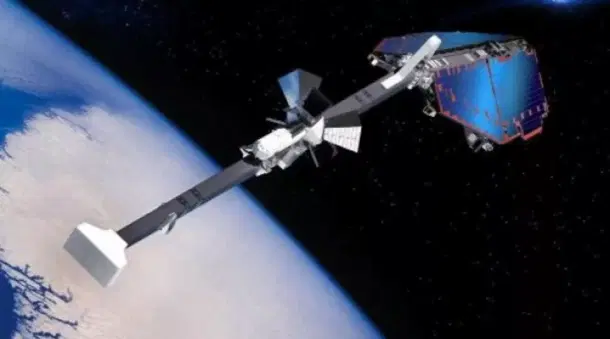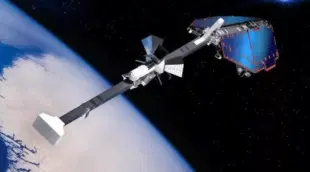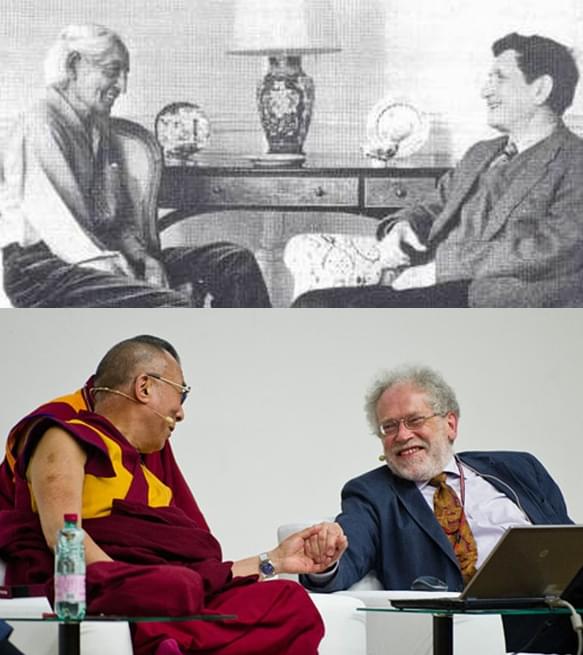Science
What China’s Quantum Breakthrough Means For India
Aravindan Neelakandan
Jul 14, 2017, 06:55 PM | Updated 06:55 PM IST
Save & read from anywhere!
Bookmark stories for easy access on any device or the Swarajya app.


In what looks like a page materialising straight from science fiction, China has achieved the first successful teleportation of a photon into space. This is a tremendous achievement and the fundamental paradoxical irony underlying it cannot go undetected, even by quantum encryption.
What lies at the heart of this technological feat is EPR (Einstein–Podolsky–Rosen) paradox. Originally a theoretical effort to undermine quantum mechanics’ depiction of reality, Albert Einstein along with fellow physicists Boris Podolsky and Nathan Rosen, pointed out the ‘spooky action at a distance’ as an impossible outcome of quantum mechanics. What was a thought experiment to criticise the Copenhagen Interpretation of Quantum Mechanics, the debate about which made Einstein famously quip that god does not play dice with the universe, has today literally giant-leaped into a very real space experiment.
In between the 1935 EPR paper and the 2017 Space-earth photon ‘teleportation’ there are some important pages. In 1952, David Bohm, the great theoretical physicist had proposed some improvements to the original EPR paradox. He suggested that there might be some hidden variables and the universe after all may be a deterministic one as Einstein thought. In 1964, Irish physicist John Bell working on Bohm’s ideas, figured out how the EPR paradox could be made into real physical experiments.
.jpg?w=610&q=75&compress=true&format=auto)
Einstein has considered two electrons with known quantum states from a source. When the position of one of these electrons is measured at some point, then that automatically changes the position of the other electron. The changes in the measurements of one particle brought about by measuring another particle at a very great distance is the ‘spooky action’ Einstein talked about. It was Erwin Schrodinger who had described Einstein’s proposed electrons from the source as being "entangled" (verschrankt). Now, the phenomenon is popularly known as "quantum entanglement”.
After the theoretical possibility becoming an experiment in real life, there have been no full stops. In technology, it paved the way for quantum computing. The bit that we use in classical computing has on and off states. In quantum computing, the basis is qubit which has the values 0 and 1 and also the superimposed state. This along with quantum entanglement paved the way for what is known as quantum teleportation – instantaneous transfer of information.
The pioneer in the field of quantum teleportation is Austrian physicist Anton Zeilinger. He succeeded in quantum teleporting. It should be remembered here that quantum teleportation is NOT the ‘beaming’ up one sees in science fiction movies. It is not the physical object that is teleported, but its quantum states. The paper ‘Experimental Quantum Teleportation’ published in Nature in the December of 1997 by Zeilinger and his colleagues announced the exciting news in a language that all can understand:
.jpg?w=610&q=75&compress=true&format=auto)
Quantum teleportation — the transmission and reconstruction over arbitrary distances of the state of a quantum system — is demonstrated experimentally. During teleportation, an initial photon which carries the polarisation that is to be transferred and one of the pairs of entangled photons, are subjected to a measurement such that the second photon of the entangled pair acquires the polarisation of the initial photon. This latter photon can be arbitrarily far away from the initial one. Quantum teleportation will be a critical ingredient for quantum computation networks.
They also observed the tremendous technological possibilities inherent in them: “Besides the promising developments of quantum cryptography (the first provably secure way to send secret messages), we have only recently succeeded in demonstrating the possibility of quantum dense coding, a way to quantum mechanically enhance datacompression.”
.jpg?w=610&q=75&compress=true&format=auto)
On 16 August 2016, China launched Micius – a satellite which can generate quantum entangled photons. It can send the entangled photons to land stations in Austria and China. Placed at sun-synchronous orbit 500 kilometres above the earth, (1,400 km at horizon), Micius also has ultra-sensitive light detectors, which can detect the quantum states of the photons it gets from the Earth. With the land station established at 4,000 metres above the altitude at the occupied territory of Tibet (thus reducing the distance of atmospheric interference with the photons), Chinese teams have been creating entangled photon pairs from the base at the rate of 4,000 per second. Thirty two days and millions of photons later 911 cases turned triumphant. The Chinese team has announced ‘the first quantum teleportation of independent single-photon qubits from a ground observatory to a low Earth orbit satellite — through an up-link channel — with a distance up to 1,400 km’. They have further announced that their achievement ‘establishes the first ground-to-satellite up-link for faithful and ultra-long-distance quantum teleportation, an essential step toward global-scale quantum internet’.
The socio-political paradox of totalitarian Chinese government announcing a major technological breakthrough in the formation of quantum internet is too obvious to ignore. A country, where internet censorship is very high, is moving towards the realisation of quantum internet that provides the highest standards of web-based privacy. Quantum internet communications based on q-cryptography are theoretically impossible to crack.

There are other fundamental ironies as well. Marxist governments have traditionally run inquisition against quantum mechanics. Often their theoreticians denounced the new physics as ‘bourgeois science’ and ‘decadent fall into mysticism’. Sure enough, even in the path to quantum computing and teleportation of the scientists we saw, Bohm was almost a mystic and his conversations with philosopher J Krishnamurthy are legendary. Anton Zeilinger the man who made the first quantum teleportation over the distance of more than 100 km, had invited the Dalai Lama to his laboratory. He and his colleagues had visited Dharamsala and discussed quantum physics and cosmology with the Dalai Lama.
Despite all these hurdles at the theoretical level, the Chinese had pulled off a technological achievement over all others in the field of q-computation. Of course, behind this success is a huge human cost. The Long March rocket series of which one took the satellite to sun-synchronous orbits have been tested with the least concern for human safety. Failed rocket launches had exploded over populous villages and casualties are unknown to the outside world. They could build their satellite land centres in high altitude places of occupied Tibet and still engineer the cooperation of global scientific community. All these have gone into the success, which is definitely a great milestone in the history of science.
What about India?
India is bound to compete with China in science and technology. However India does not have the luxury of the tyranny of state power. It has chosen the harder path. It has chosen democracy and still she has to achieve and perhaps even outsmart the Chinese competition. When Sputnik was launched by the Soviets, it shocked the Americans because they realised not just the technological superiority of the then USSR but also the propaganda value of the achievement – that the Marxist society is superior to democratic society. Today India faces the same challenge.
Unlike Marxist China, India does not have any dogmatic opposition to quantum mechanics or genetics. India has to revamp its education system. It should make science popular and interesting for the coming generations. Unfortunately, Nehruvian ‘scientific temper’ degenerated into a political slogan often aimed at slandering the Indian culture as ‘unscientific’. It has had two major ill effects. One is the absolute psychological alienation of the masses from science as something alien to Indian culture. Another is the childish cargo-cult like claims of the Eric Von Daniken variety. We need to revamp not only our educational system, but also the socio-cultural orientation towards science.
It is not an accident that China has also emerged a major contributor to global science fiction. China has ignored all the ideological incompatibilities its official dogma has with the worldview of quantum mechanics. India, in this regard, actually had an initial advantage over China. In fact, then some Indian teams sitting in absolutely impoverished science departments in isolated universities in India were competing with global leaders of science in unravelling profound mysteries in science of that day. Yet down the line China has beaten us down and has emerged as a world leader in the technology of the people.
While China can build anything anywhere for making itself a world leader in science and technology, in India, as we just saw in the case of Neutrino Observatory in Tamil Nadu, a bunch of lunatic Luddites stopped the international project in science that could benefit the nation and humanity. Given all her handicaps, and her ethically laudable determination to stick to democracy rather than dictatorship, India does have impressive achievements in science and technology. In his recent book Deep Thinking, while pointing out to Chinese ascendancy in the field of artificial intelligence, Gary Kasparov recalls the response of the US to the ‘crisis’ in telling words:
Sputnik stoked American fires in the most primeval ways: creating fear and anger, and denting America’s national ego and pride. The United States responded. In 1958, three years before President John F. Kennedy boldly promised to put a man on the moon by the end of the decade, then–Senator Kennedy supported legislation called the National Defense Education Act, which directly funded science education across the country. The future engineers, technicians, and scientists produced by the program would form the generation that designed and built much of the digital world we live in today.
Today, US may have lost that fire. But India, being China’s neighbour and a competitor at many levels, is governed by the same equations which governed the US attitude to Soviet technological achievements. And for us, the task is even more complex and needs more of an indomitable focus and execution. We represent a pluralist democracy and an ancient nation. We do not have the luxury to be defeated in the vital fields of science and technology by an expansionist undemocratic neighbour.
Aravindan is a contributing editor at Swarajya.





